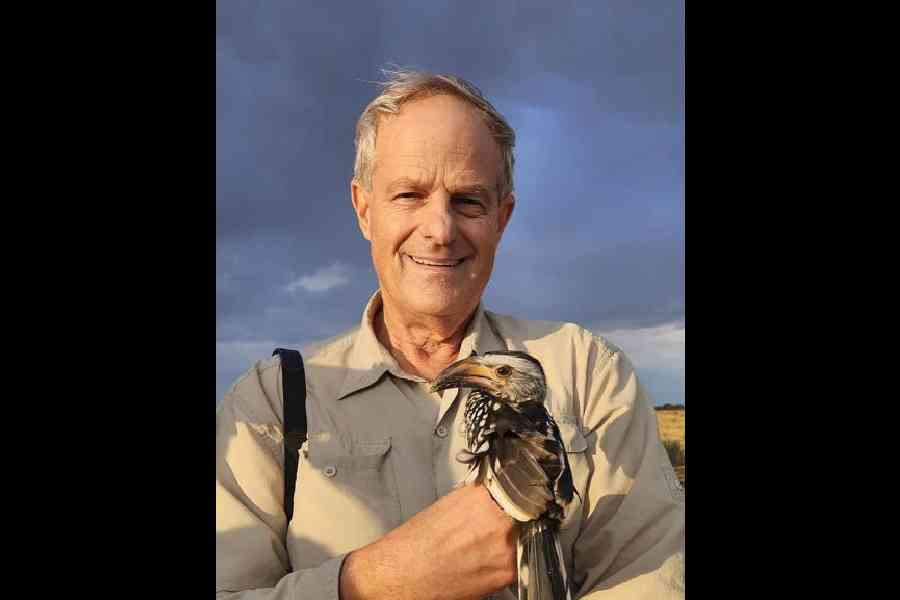In the world of birding, Peter Kaestner stands alone. No one has seen and identified more birds than Kaestner, a retired US diplomat who aspires to become the first birder to spot 10,000 of the planet’s roughly 11,000 avian species. With 9,697 on his eBird list so far, he is getting close.
Yet for all the birds he has looked for and found, there remain a few that he has looked for and not found. He doesn’t forget them.
There was the Congo peacock — a rare multicoloured pheasant of the Central African rainforest — that he missed in 1978, when his travelling party was stymied by a crash on the remote airstrip they planned to search. There was a black-browed albatross he pursued off
the German coast in 2015, some 300 miles and a four-hour ferry ride from Kaestner’s home in Frankfurt
at the time.
“I made four 10-hour trips to twitch it, to no avail,” Kaester wrote in an email. “And once, I missed it by
20 minutes!”
Through such trials, birders develop what they call “nemesis birds”, birderspeak for the species that
bedevil them again and again, despite their best efforts. As birding surges in popularity, the hobby’s unique parlance requires explanation (see box).
“It’s a species that eludes you after multiple attempts, especially if the bird was or should have been there,” Kaestner said. “There is a connotation that something supernatural is getting
between you and seeing
the bird.”
An article in Audubon in 2017 by Dan Koeppel defined a nemesis bird as “one common enough that a dedicated birder should have spotted it, but that nevertheless remains unseen.” Koeppel, an author and science writer, has since broadened the definition slightly, noting it can mean different things to birders of different skill and interest levels.
“If it’s a bird that drives you crazy, you can call it a nemesis bird,” Koeppel said. “It could be a bird your mom has seen, but you haven’t.”
What causes a person to be driven crazy by birds? By now, the positive health benefits of birding are well-documented, and the US Fish and Wildlife Service estimates that about 45 million Americans identify as birders. But what causes a person to obsess over one particular bird? That is something altogether specific and personal.
“The concept of nemesis birds is one of the things my nonbirder friends are most confused, then amused, by,” Danielle Khalife, a public health researcher from the New York City borough of Brooklyn, US, said. “Somebody asked if it was birds that you hate. Not exactly.”
Sometimes a bird’s novelty makes it a nemesis. Since getting into birding during the pandemic, Khalife has yet to spot a yellow-breasted chat, despite several reported sightings in nearby Prospect Park. Chats are large secretive warblers uncommon north of Delaware and, as their name
suggests, more often heard than seen.
“They’re an elusive bird, so that makes me feel a little bit better,” Khalife said.
Sometimes it’s simply desire. Howard Fischer, 72, a retired educator on New York City’s Staten Island borough, US, has seen more than 3,000 species in 57 years of birding. But it took nearly five decades to lay eyes on a varied thrush, a bedazzling orange-and-black relative of the robin that is common in the Northwest.
Fischer travelled to the thrush’s normal range, coming up empty in Washington, Montana and British Columbia. He also chased reports of rare sightings that were more local: one in New Hampshire, one in New Jersey, another in Central Park, US.
Sometimes, it’s grief. Koeppel’s father, Richard, was among the most accomplished birders of the 20th century, tallying 7,000-plus species worldwide before his death in 2012. But one always eluded him: the mountain quail, a rotund game bird of the Pacific Slope mountains.
“Think about the word ‘quail’ — it means to flinch away, to hide,” Koeppel said. “The very name of the bird is telling you it doesn’t want to be around you.”
After his father made it his dying wish to see one, Koeppel spent almost five years searching for a mountain quail. He couldn’t disperse his father’s ashes until he succeeded.
When Koeppel finally stumbled upon a pair of mountain quail in a Southern California state park, he could hardly believe it. He dashed back to his car to retrieve the urn, and together he and his young son threw their patriarch’s ashes toward the birds.
“It was a total ‘Big Lebowski’ kind of thing, where we both got covered in this white powder,” Koeppel said. “It was kind of amazing. It became a very emotional moment.”
Sometimes it’s something else about nemesis birds — how they can, with persistence, be overcome. Kaestner spent time this summer on the Indonesian island of Sumatra searching for several of its endemic species. One of his targets, the rare and reclusive Schneider’s pitta, eluded him on a previous attempt in 1993. This time, the search required a long hike up Mount Kerinci, the country’s largest volcano, and a nine-hour stakeout before the bird finally appeared.
“Got the pitta today,” Kaestner reported from the field via text. “Maybe I’ll have a new nemesis tomorrow!”
NYTNS










